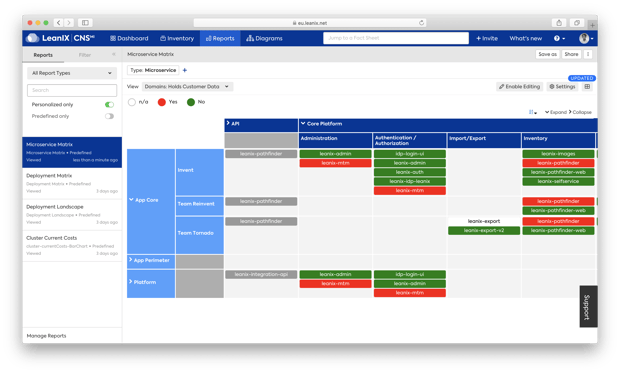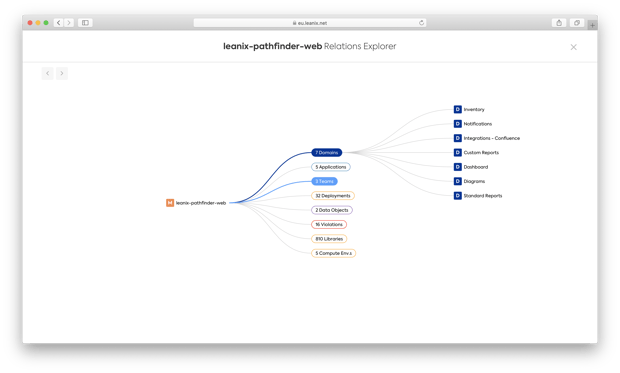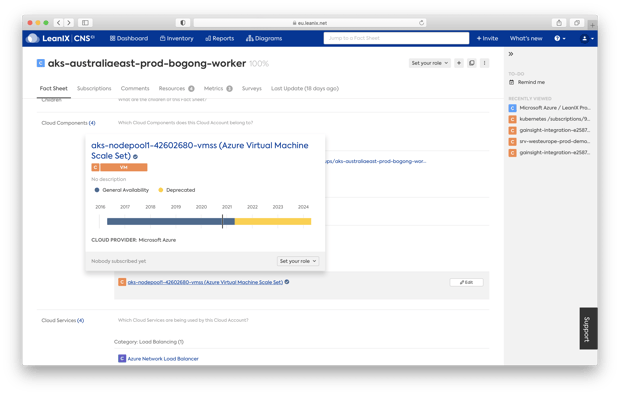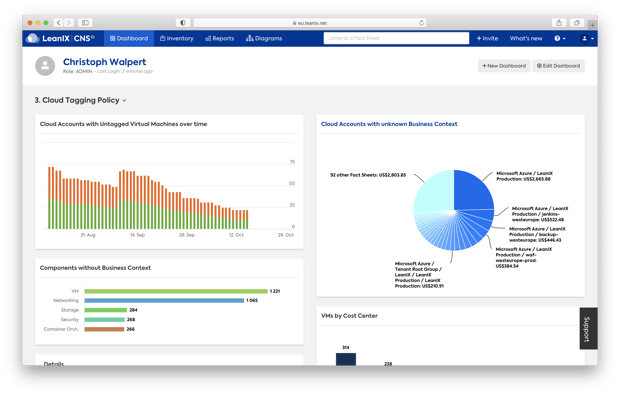
Many of today’s prevailing methods for IT management can’t track the day-to-day realities of DevOps teams — that is, in ways that let developers work uninterrupted while giving business stakeholders constant lines of sight into their activities. Though it was once feasible for application owners to document architectures by manually updating and aggregating product data, these approaches are highly impractical when sustaining cultures of continuous integration and continuous delivery (CI/CD). Now, in order to embed microservices architecture into core business processes, smart forms of governance are necessary to prevent the following:
- Missing visibility into key cloud-based services
- Uncontrolled costs and risks
- Slow response times due to unclear ownership
LeanIX’s line of SaaS-based solutions for aligning IT with business has evolved to support DevOps teams when building continuously deployable systems. For the purposes of agile development, this means leveraging features that empower teams and connect one another to state-of-the-art tooling, and in terms of cloud native governance, this includes mechanisms for keeping budget and compliance under control.
The full extent of these cloud governance capabilities are covered in full in the LeanIX blog. But for your interest, here’s information from a presentation I gave on how to use LeanIX to integrate CI/CD environments and enable:
- Automated inventorying of microservices
- Continuous monitoring of technology lifecycles
- Consistent and reliable tagging policies
Automated inventory of microservices
LeanIX Microservices Intelligence is used at LeanIX to help manage the many microservices underlying its product offerings. With information on the lifecycles of cloud resources and tagging policies in one location, various matrices can be accessed in Microservices Intelligence to help developers and non-developers alike segment production environments according to precise views. Resources can be split across domains and sub-domains (e.g., APIs, Administration, Inventory, Notification), and each can be viewed alongside the users responsible for their upkeep.
Source: LeanIX GmbH
As a result of having information on microservices both consolidated and contextualized, support teams can, for example, rely less on feedback from developers when assessing technical issues, and through the tool, make decisions on escalations faster and more autonomously. Connected to every Fact Sheet in Microservices Intelligence are quick-access links to outside documentation — such as API and metadata description pages — to educate those unfamiliar on elements of cloud-based services. This analysis can be coupled with holistic understandings of the underlying technology, data objects, security violations, and other such information comprising a microservice via an interactive relations explorer.
Source: LeanIX GmbH
Continuous monitoring of technology lifecycles
To complement analysis on cloud infrastructures, Microservices Intelligence presents users with seamless links to LeanIX Microservice Intelligence, a corresponding module in the CNS encompassing unique views on automatically-discovered data from hyperscalers. No matter how broad a cloud landscape, Cloud Intelligence is purpose-built to store dynamic volumes of data on every type of cloud native asset. This information can be filtered according to common architectural attributes (i.e., data quality, ownership, hierarchy), and alerts on common cloud violations (e.g., availability, best practices, security, performance, billing) are imported directly from vendor-specific monitoring tools.
In my presentation, I showed how a Microsoft Azure-managed resource group can be differentiated by various categories, and by simply just hovering over the associated virtual machine (VM), it can be checked whether a service is still within in general availability or being deprecated. This information is aggregated within a Cloud Provider Support dashboard showing the total numbers of unsupported cloud components, split by technology and function (e.g., storage, security, data management, load balancing), wherein users can investigate which elements of a particular service are deprecated or unsupported.
Source: LeanIX GmbH
Consistent and reliable tagging policies
Tagging policies are integral to any successful cloud governance setup. From performing cost management to pinpointing where specific VMs are being run (i.e., productive, development, or testing environments), a well-managed cloud tagging policy can reduce infrastructure sprawl and help scale cloud usage appropriately. Our latest white paper has insights on tag naming and conventions, but in terms of governance, Cloud Intelligence customers are provided customizable dashboards for quick views into tag implementation efforts.
Source: LeanIX GmbH
Of note, to benefit Cloud Cost Centers of Excellence (CCoEs) and other groups responsible throughout organizations for cloud governance, these dashboards can be leveraged to monitor KPIs such as how thoroughly VMs are being tagged. Filters can then be activated to retrieve lists of all untagged VMs plus their current and historical costs to prioritize documentation efforts. Tagging implementation can also be framed to reveal whether the cloud resources of certain business departments are more well-defined and contextualized than others, and to spur problem-solving, automated notifications are sent to account owners for doing so (e.g., generating Slack messages whenever VMs reach a certain cost or miss a critical tag).




.png?width=140&height=107&name=BTMPlaybook-FI%20(1).png)

